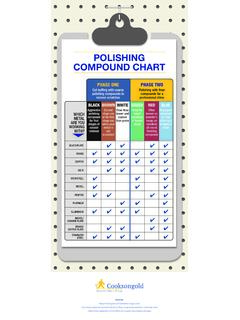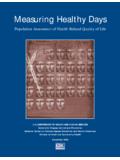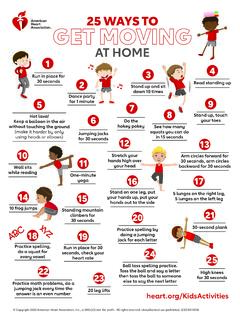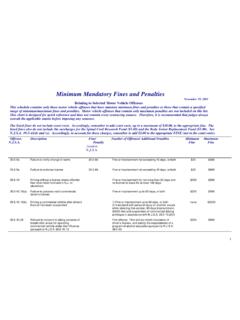Transcription of MMMATTERATTERATTER INININ O O OURURUR S S …
1 As we look at our surroundings, we see a largevariety of things with different shapes, sizesand textures. Everything in this universe ismade up of material which scientists havenamed matter . The air we breathe, the foodwe eat, stones, clouds, stars, plants andanimals, even a small drop of water or aparticle of sand every thing is matter. Wecan also see as we look around that all thethings mentioned above occupy space andhave mass. In other words, they have bothmass* and volume**.Since early times, human beings havebeen trying to understand their Indian philosophers classified matter inthe form of five basic elements the Panch Tatva air, earth, fire, sky and to them everything, living or non-living, was made up of these five basicelements.
2 Ancient Greek philosophers hadarrived at a similar classification of day scientists have evolved twotypes of classification of matter based on theirphysical properties and chemical this chapter we shall learn aboutmatter based on its physical aspects of matter will be taken upin subsequent Physical Nature of MATTER IS MADE UP OF PARTICLESFor a long time, two schools of thought prevailedregarding the nature of matter. One schoolbelieved matter to be continuous like a blockof wood, whereas, the other thought that matterwas made up of particles like sand. Let usperform an activity to decide about the natureof matter is it continuous or particulate?
3 Take a 100 mL beaker. Fill half the beaker with water andmark the level of water. Dissolve some salt/ sugar with the helpof a glass rod. Observe any change in water level. What do you think has happened tothe salt? Where does it disappear? Does the level of water change?In order to answer these questions weneed to use the idea that matter is made upof particles. What was there in the spoon, saltor sugar, has now spread throughout is illustrated in Fig. SMALL ARE THESE PARTICLESOF MATTER? Take 2-3 crystals of potassiumpermanganate and dissolve them in100 mL of :When we dissolve salt in water, the particlesof salt get into the spaces between particlesof water.
4 *The SI unit of mass is kilogram (kg).**The SI unit of volume is cubic metre (m3). The common unit of measuring volume islitre (L) such that 1L = 1 dm3, 1L = 1000 mL, 1 mL = 1 INININININ O O O O OURURURURUR S S S S SURROUNDINGSURROUNDINGSURROUNDINGSURROUN DINGSURROUNDINGSC hapter2022-23 SCIENCE2 Take out approximately 10 mL of thissolution and put it into 90 mL of clearwater. Take out 10 mL of this solution andput it into another 90 mL of clear water. Keep diluting the solution like this 5 to8 times. Is the water still coloured ? OF MATTER ARECONTINUOUSLY Put an unlit incense stick in a cornerof your class.
5 How close do you have togo near it so as to get its smell? Now light the incense stick. Whathappens? Do you get the smell sittingat a distance? Record your Take two glasses/beakers filled withwater. Put a drop of blue or red ink slowlyand carefully along the sides of the firstbeaker and honey in the same way inthe second beaker. Leave them undisturbed in your houseor in a corner of the class. Record your observations. What do you observe immediately afteradding the ink drop? What do you observe immediately afteradding a drop of honey? How many hours or days does it takefor the colour of ink to spread evenlythroughout the water?
6 Drop a crystal of copper sulphate orpotassium permanganate into a glassof hot water and another containingcold water. Do not stir the the crystals to settle at thebottom. What do you observe just above thesolid crystal in the glass? What happens as time passes? What does this suggest about theparticles of solid and liquid? Does the rate of mixing change withtemperature? Why and how?From the above three activities ( , ), we can conclude the following:Fig. : Estimating how small are the particles ofmatter. With every dilution, though the colourbecomes light, it is still experiment shows that just a fewcrystals of potassium permanganate cancolour a large volume of water (about1000 L).
7 So we conclude that there must bemillions of tiny particles in just one crystalof potassium permanganate, which keep ondividing themselves into smaller and same activity can be done using2 mL of Dettol instead of potassiumpermanganate. The smell can be detectedeven on repeated particles of matter are very small they are small beyond our imagination!!!! of Particles OF MATTER HAVE SPACEBETWEEN THEMIn activities and we saw that particlesof sugar, salt, Dettol, or potassiumpermanganate got evenly distributed in , when we make tea, coffee orlemonade (nimbu paani ), particles of one typeof matter get into the spaces between particlesof the other.
8 This shows that there is enoughspace between particles of IN OUR SURROUNDINGS3 If we consider each student as aparticle of matter, then in which groupthe particles held each other with themaximum force? Take an iron nail, a piece of chalk anda rubber band. Try breaking them by hammering,cutting or stretching. In which of the above threesubstances do you think the particlesare held together with greater force? Take some water in a container, trycutting the surface of water with yourfingers. Were you able to cut the surface ofwater? What could be the reason behind thesurface of water remaining together?
9 The above three activities ( , and )suggest that particles of matter have forceacting between them. This force keeps theparticles together. The strength of this force ofattraction varies from one kind of matter of the following arematter?Chair, air, love, smell, hate,almonds, thought, cold, lemonwater, smell of reasons for the followingobservation:The smell of hot sizzling foodreaches you several metresaway, but to get the smell fromcold food you have to go diver is able to cut throughwater in a swimming pool. Whichproperty of matter does thisobservation show? are the characteristics ofthe particles of matter?
10 Particles of matter are continuouslymoving, that is, they possess what we callthe kinetic energy. As the temperature rises,particles move faster. So, we can say that withincrease in temperature the kinetic energy ofthe particles also the above three activities we observethat particles of matter intermix on their ownwith each other. They do so by getting intothe spaces between the particles. Thisintermixing of particles of two different typesof matter on their own is called diffusion. Wealso observe that on heating, diffusionbecomes faster. Why does this happen? OF MATTER ATTRACTEACH Play this game in the field make fourgroups and form human chains assuggested: The first group should hold eachother from the back and lock armslike Idu-Mishmi dancers (Fig.)















